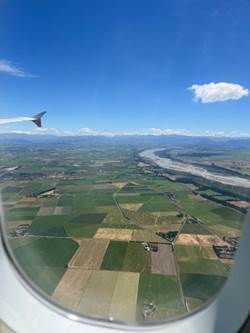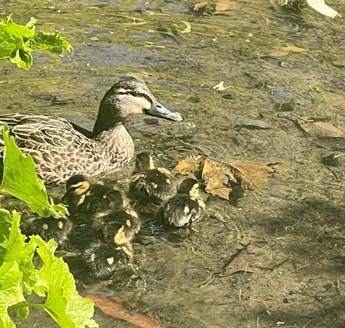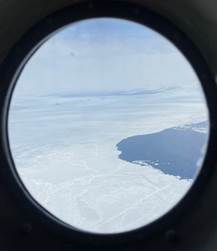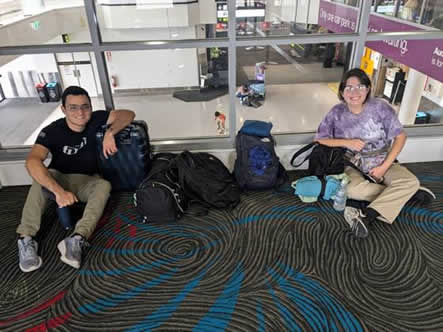
We leave for New Zealand on 7 December and arrive in Christchurch, after the time change, on 9 December and will have two days there to prepare for our flight to McMurdo Station.
I am accompanied by two PhD students, Valerie Munoz and Juan Zuluaga. I will be excavating penguin remains (bones, eggshell, feathers, and even mummies) from ancient as well
as active penguin colonies to investigate the long-term paleohistory and occupation of penguins in the Ross Sea region over the past 10,000 years. Valerie will be collecting data for her
PhD research on stable isotope analyses of ancient and modern Adélie penguins. Juan just completed his PhD on thermalregulation in birds so will be bringing a heat sensing camera
to assess how penguins exchange heat with their environment as a side project. We will be in Antarctica through January, which will include a visit to the Italian research station Mario
Zucchelli. Lots of exciting things ahead so stay tuned for all our blog posts here!
9-12 December 2024: The Penguin Team Heads South!
Penguin Team: Dr. Steve Emslie, Dr. Juan Zuluaga, and graduate student Valerie Munoz
We finally departed from Wilmington on 9 December and had three flights, one over 15 hr long, to reach Christchurch, New Zealand, where the U.S. Antarctic Program is headquartered for all the logistics and science in the Ross Sea at McMurdo Station. After a rest at our hotel, we spent the next two days in Christchurch completing final preparations for our flight to McMurdo. On the first evening here, we walked over to the statue of Robert Falcon Scott in the city center, a good place to begin our visit. We had time to also visit the International Antarctic Center where one of my former students, Megan Reaves, now works while also completing her PhD at the University of Canterbury. She introduced us to many of the staff and we were treated to a ‘backroom tour’ of the Little Blue Penguins that were found on local beaches in need of rehabilitation. We also experienced their cold room that simulated a storm in the Antarctic complete with wind chill! This was great for Juan and Valerie to give them a taste of what is to come as this is their first visit to the Antarctic. We also had some training and orientation to complete for the U.S. Antarctic Program, then we received our issue of extreme cold weather (ECW) clothing that provides us with a heavy red coat, insulated boots, hat, googles, and other gear we will need when working in the field.

Juan and Valerie at the Auckland airport waiting for our last flight
to Christchurch, 9 December 2024
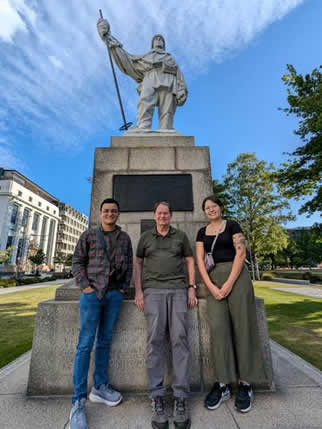
Juan, Steve, and Valerie at the statue of Robert Falcon Scott
in Christchurch, 9 December 2024

Juan experiencing wind chill in the cold room at the
International Antarctic Center, Christchurch
As often happens early in the summer season at McMurdo, the weather is unstable and our scheduled flight from Christchurch on 12 December was delayed for two more days. So, we continue to enjoy our visit to the city and wait for word that it will be time to head out to the airport and board our flight to McMurdo.
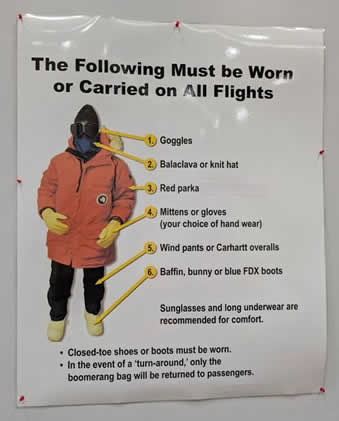
A poster showing the type of clothing we are issued in
Christchurch before we leave for the Antarctic.
13-14 December: McMurdo Station
Our two-day delay in Christchurch was suddenly shortened to just one day as we learned while having dinner on the 12th after more touring around the city to visit local sites that day. So we packed up that night and went to bed early as we had to meet the shuttle to the airport at 5:15 am. We then arrived at the airport for a briefing and had time for a quick breakfast before we boarded a New Zealand Airforce C-130, a workhorse aircraft designed for carrying lots of cargo but not built for comfort for its passengers! We were crowded in for a 6-hr flight and left at 9 am. It was a nice smooth flight, though, and we landed on the Ross Ice Shelf Phoenix airfield near McMurdo Station at 3 pm. It was a sunny and calm day and we boarded another shuttle, a delta bus, to take us across the ice shelf to the shore of Ross Island, past the New Zealand Scott Base, and then over to McMurdo Station where we entered Crary Science Lab for a briefing and to get our room assignments. We were glad to have made it here as some groups before us had been delayed in Christchurch by a week or more from bad weather at McMurdo.

Juan checking in at the Christchurch airport for our flight
to McMurdo Station, 13 December 2024
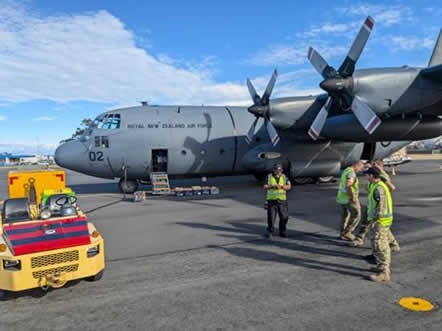
The New Zealand C-130 aircraft, ready for us to board in Christchurch
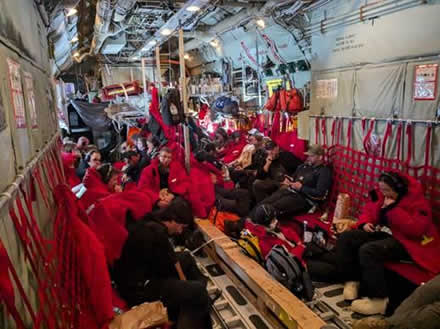
Packed in and flying south!
Since arriving at McMurdo it has been very busy for us, completing required trainings, gathering field equipment, and arranging our lab area we were assigned. We did have time to do a short hike out to the historic Discovery hut on Hut Point, built in 1902 by Robert Falcon Scott during his first visit to Antarctica, and then a longer hike to the top of Observation (Ob) Hill where we had nice views of the station and the ice shelf to the south. We will continue with trainings and field preparation over the next two days and we hope to start our field work by mid week, weather dependent. Stay tuned for our first posts on the field work!
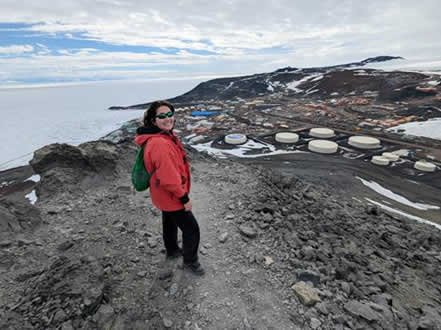
Valerie on Ob Hill with a nice view of McMurdo Station below,
14 December 2024
18-19 December 2024
The past two days we’ve had beautiful weather at McMurdo and Valerie, Juan and I were able to go out in the field on both days. We flew in an AStar helicopter on Wednesday just a short distance to our first site, an ancient penguin colony at Cape Barne on Ross Island. Not only was this the first helicopter ride that Juan and Valerie have ever experienced, it also was their first day in the field in Antarctica and it was a good one!
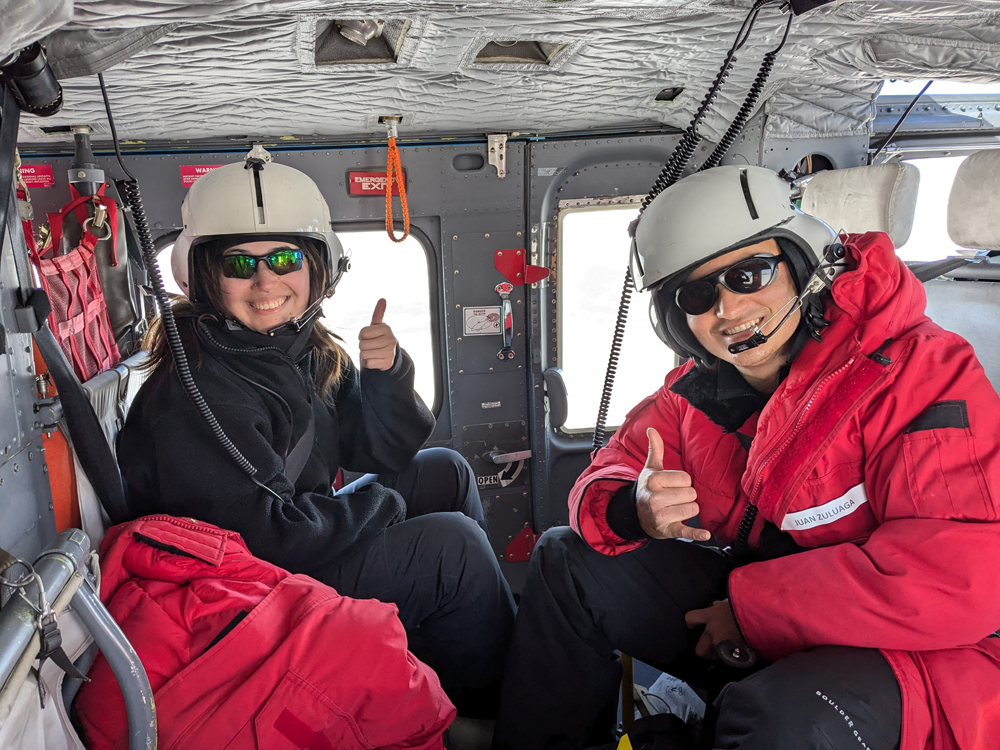
First helicopter flight for Valerie and Juan!
Cape Barne is known to be the most southern Adélie Penguin colony in Antarctica given it’s southern position on Ross Island, near the front of the Ross Ice Shelf. This colony was abandoned hundreds of years ago when there was a different environment at the time, with less sea ice blocking access to the beach that allowed penguins to breed here. Those conditions changed as ice returned so the penguins abandoned this site and now the most southern active colony is just to the north of Cape Barne at Cape Royds. I had sampled the ancient colony at Cape Barne in 2000-2001 and found an intact penguin chick mummy then so I was hoping for more on this trip. Our pilot, Nick, landed us right on the beach where the sites are located and then left us there for the next eight hours. We first surveyed the area and I relocated the spot I had sampled before. The entire beach has pebble concentrations from old penguin nests but the area at my old site still looked the best. We setup our field gear including tarp, screens, and bags and began excavating a pit not far from the one I excavated 23 years ago.
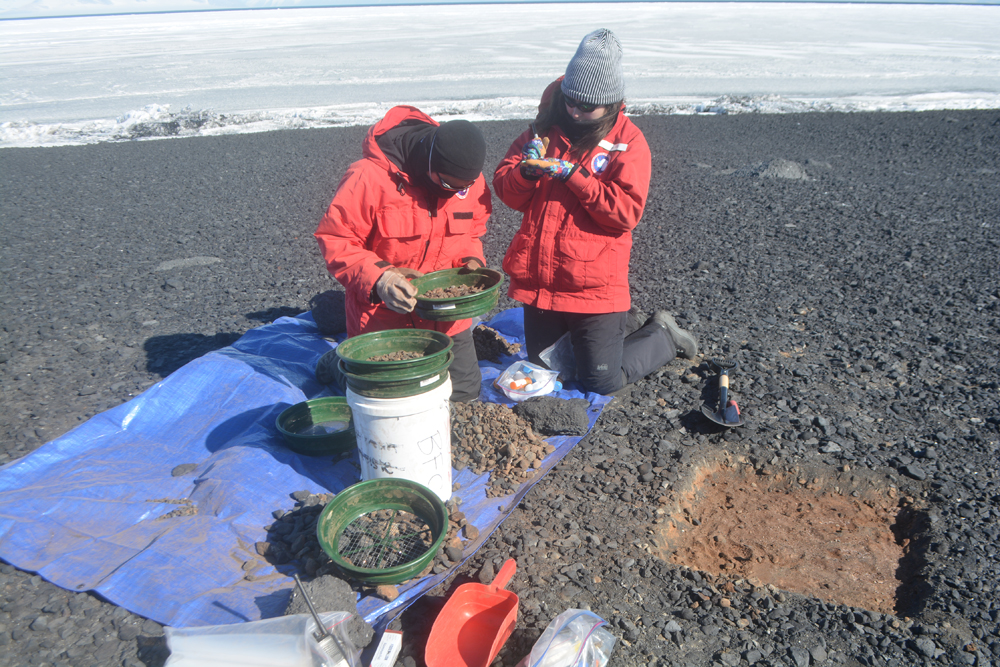
Juan and Valerie working at Cape Barne Site 1
The soil in an ancient penguin colony has a special name, ornithogenic (bird-formed) soil, that dries out over time but remains stained a pinkish red color from the krill in the penguin guano. In the dry cold climate here, these soils preserve a wealth of organic remains: bones, feathers, and eggshell from the penguins, plus hard parts of prey from their guano (fish bones and otoliths). We excavated by 5 cm levels and this site had only two levels until we hit beach gravel and sand at the bottom. However, we found two intact chick mummies so that was exciting for all of us! We also found two partial mummies of very small chicks that died soon after hatch. We can now apply various types of analyses to these remains: radiocarbon dating, stable isotope analysis to assess the diet of the birds, and RNA virus analysis. Some of these analyses will be part of Valerie’s PhD research at UNCW.
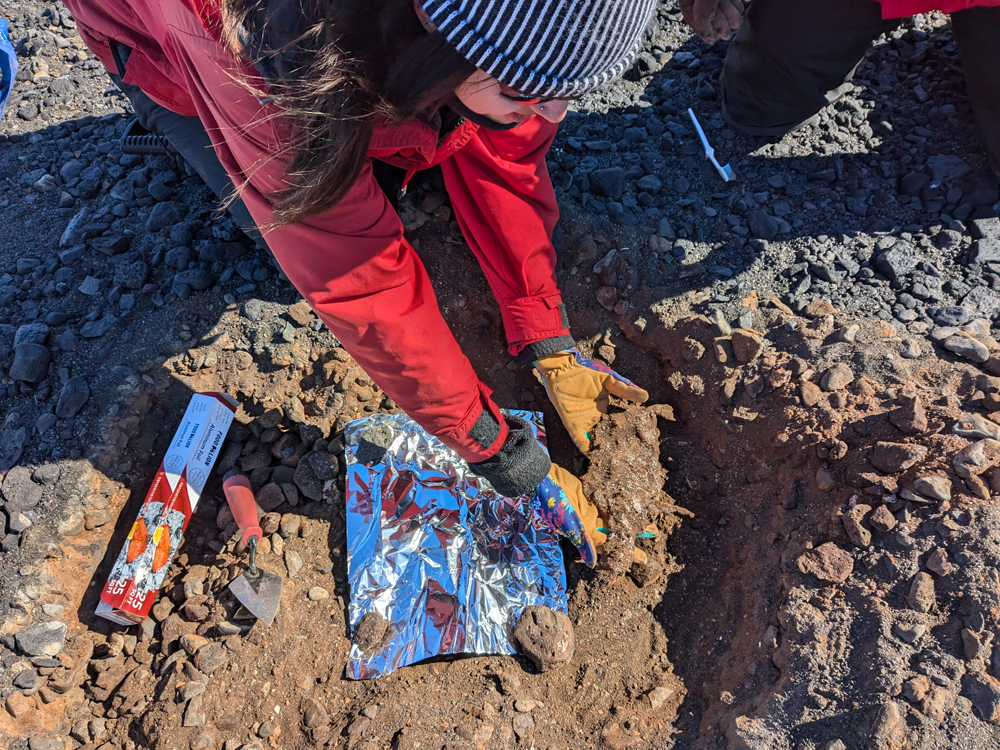
Valerie carefully removing a penguin mummy from Site 1
at Cape Barne, 18 December 2024
We backfilled this pit and moved on to another site farther to the south. In fact, our survey indicated that there was one last pebble concentration that is the most southern of all the penguin breeding sites here and we recorded its position at 77° 34’ 42.3” S. The penguins that once bred on this spot now hold the record for the most southern breeding site in Antarctica. We excavated a pit here and collected more eggshell and feathers, enough to get a radiocarbon date on this record-breaking site.
Today we worked in the area to the north of Cape Royds and found numerous abandoned sites in areas where penguins could access the beach and ridge tops. We sampled four sites and found one more mummy, so the research is going quite well! If the weather holds, we’ll be visiting Marble Point tomorrow, another area I have sampled previously with pebble concentrations dating up to 4000 years old. We will post more on this as our work progresses.

Mt. Erebus from Clear Lake area, Ross Island, 19 December 2024
24 December 2024
It’s Christmas Eve and we have today and tomorrow off for the holiday here on the station. We needed the rest after six straight days of fieldwork when we were spending most of each day out sampling at penguin colonies. The weather has been great, sunny and calm, so we were able to accomplish quite a bit. We excavated more sites at Marble Point, then went to a small island surrounded by fast ice (sea ice that connects to land), Dunlop Island, where a number of abandoned colonies are located that date to over 4000 years old. We returned to Cape Royds as well, to work in another area and near the historic hut that Ernest Shackleton placed there for his epic attempt for the south pole in 1908-1909. We had time to visit this hut and entering it is like stepping back in time with all their clothing, canned food, and other items still inside and intact thanks to the careful preservation work by the New Zealand Heritage Trust.
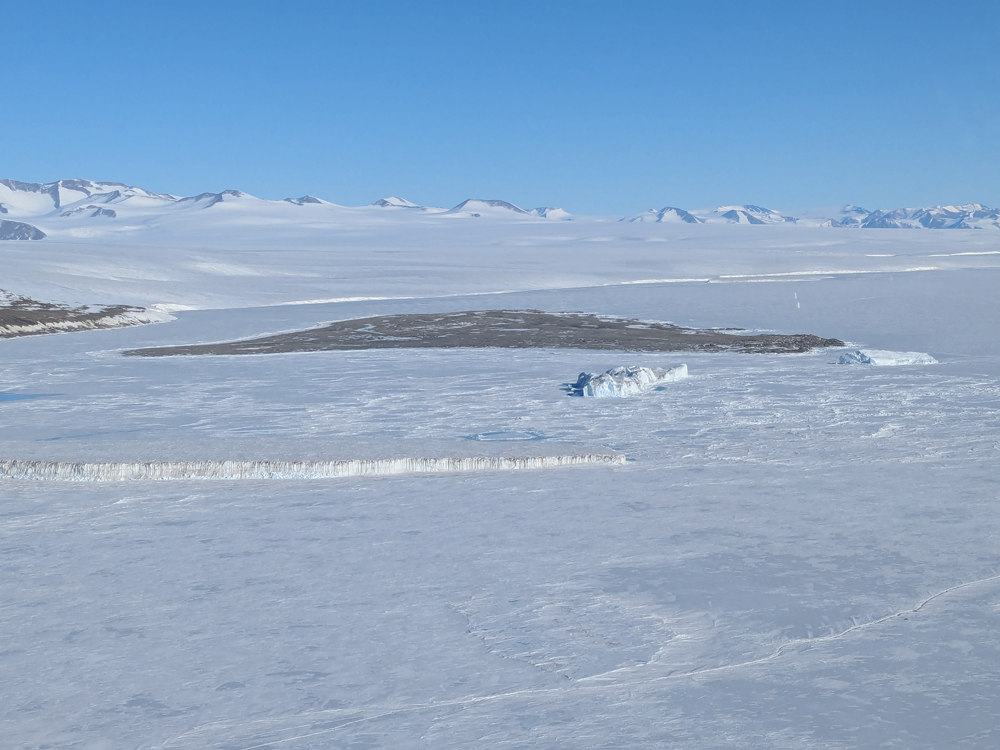
Dunlop Island is a small flat island but has a number of
ancient penguin colonies preserved on it.
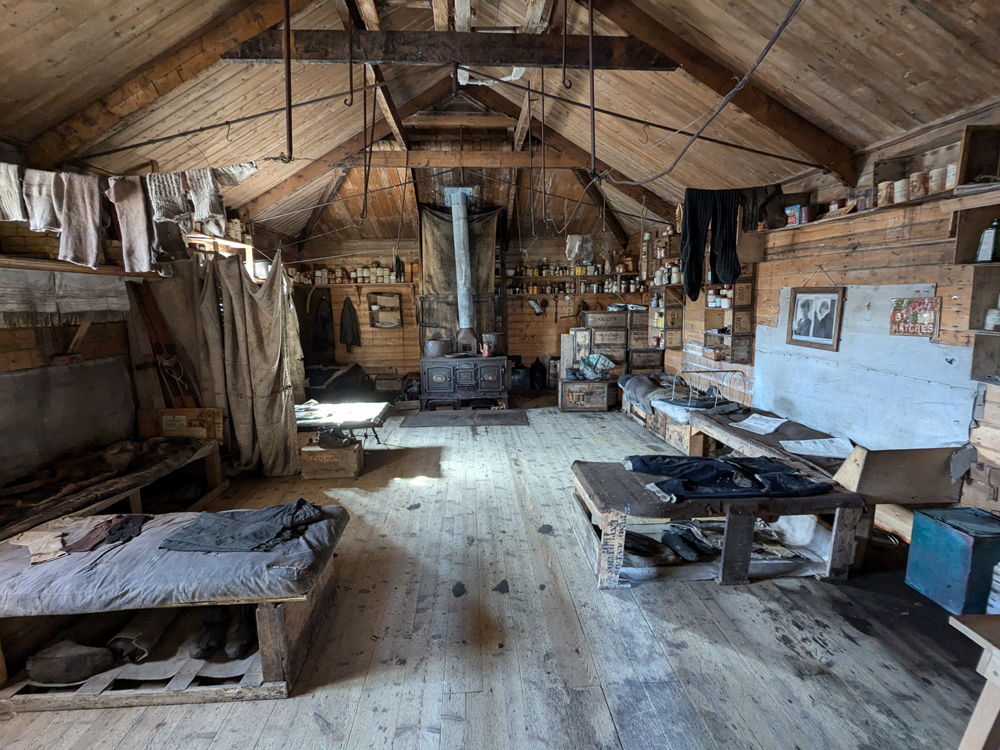
Inside Shackleton’s historic hut at Cape Royds, Ross Island
Our last field day was at Cape Crozier, on the opposite side of Ross Island from McMurdo Station and where there is one of the largest Adélie Penguin colonies in Antarctica. There is an estimated 250,000 to 300,000 breeding pair here, so it’s quite an impressive colony. We sampled some of the abandoned pebble mounds for buried penguin bones to radiocarbon date to see how old this colony might be. Some of the mounds were high up the slope of the hills above sea level, so quite a trek for the penguins to reach their nests when these were occupied. We also collected old bones from the surface for stable isotope analysis, then had time to watch the penguins as they went about their busy schedule of raising chicks. There was constant traffic of birds on the sea ice below the colony, breeding adults arriving and departing on foraging trips to feed their chicks. We witnessed birds returning to their nests, greeting their mate, then feeding the small chicks, most of which are only 1-2 weeks old at this point in the season. Sometimes by the colony, when I stood still for awhile, a penguin would wander over next to me and ‘adopt’ me—when I moved it would follow me, it would stop when I stopped, then follow me again when I walked on. They are quite amusing to watch!
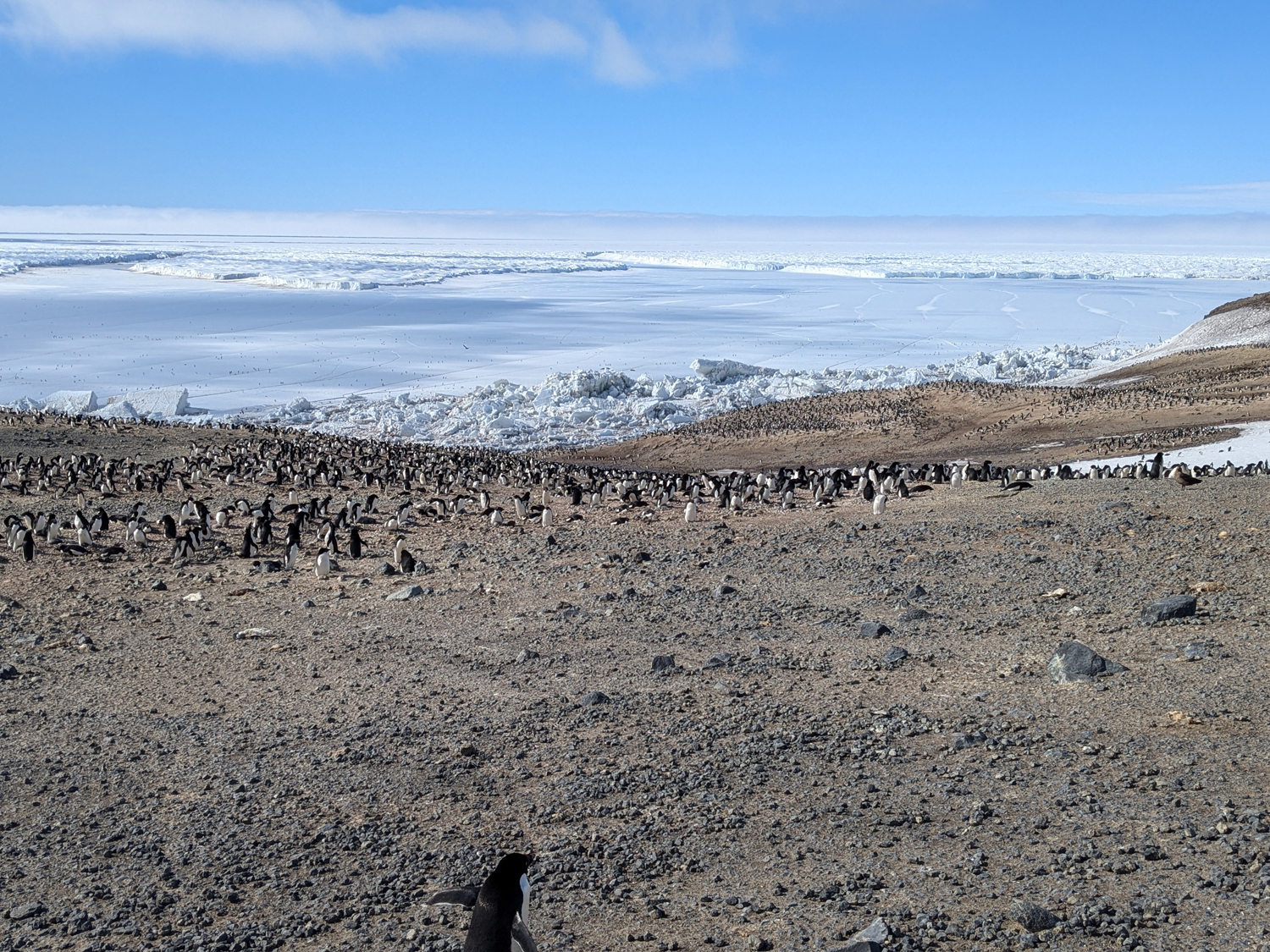
The penguin colony at Cape Crozier, looking east with the
Ross Ice Shelf in the distance.
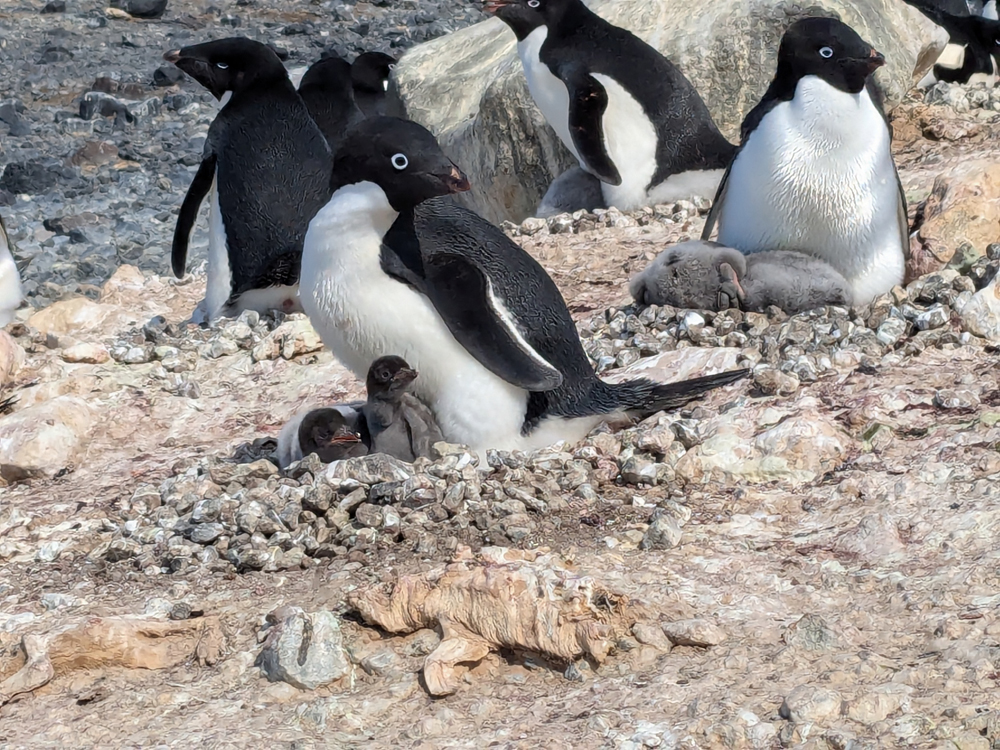
An Adélie Penguin watching over its two chicks while its mate
is out foraging for krill.
Now we have a two-day holiday for Christmas Eve and Christmas Day, which gives us a much needed rest after all the fieldwork, plus time to catch up on other things. The station cooks serve a special Christmas Eve dinner that includes lobster, crab, and roast, along with various salads and a huge selection of desserts—quite a feast! On December 26, we’ll be back at work and we hope to visit another part of the Cape Crozier penguin colony for additional sampling. We hope that the good weather lasts!
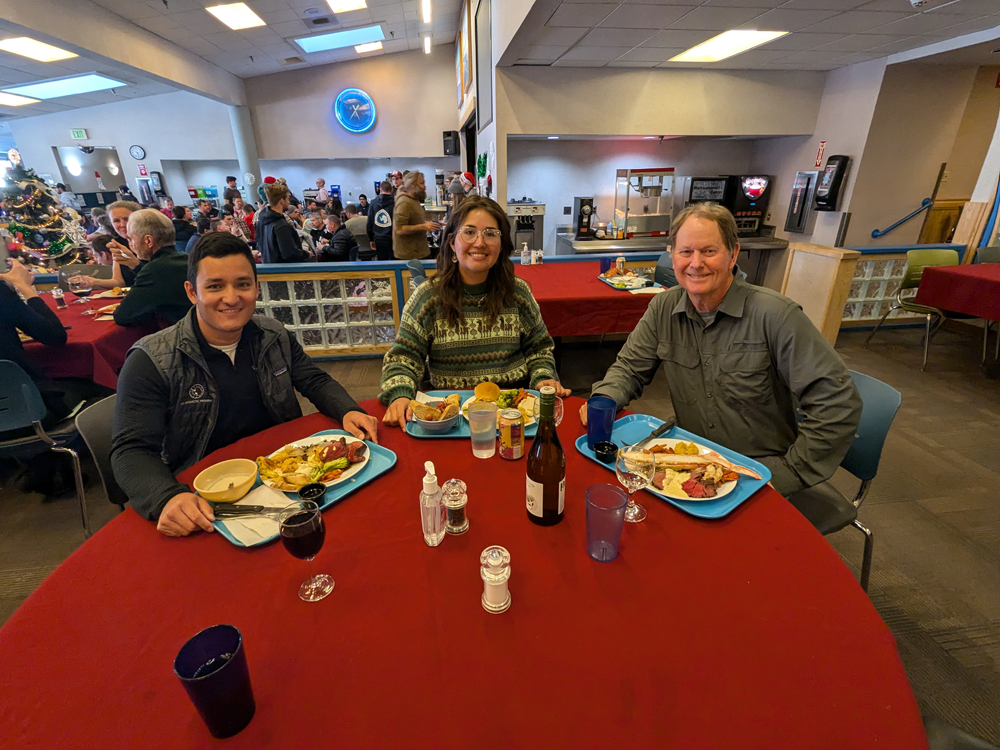
Christmas Eve dinner at McMurdo Station
28 December 2024
Since the Christmas holiday ended, we have been trying to get back in the field, but the weather has not cooperated. We started getting snow showers and low visibility on the 26th, so no helicopters could fly. Today it is beginning to clear so we are hopeful that we can get out tomorrow. In the extra time at the station, Valerie finished prepping a study skin of a South Polar Skua that we found freshly dead, apparently from fights with other skuas, at Cape Royds. The study skin preparation is a standard museum procedure to the specimen can be stored indefinitely in the natural history collections. Valerie was assisted by the station dentist, Homa, and the result was a nice study skin of this skua. I also asked Valerie and Juan to write a blog post each, giving their impressions of Antarctica so far. Their posts are given below.
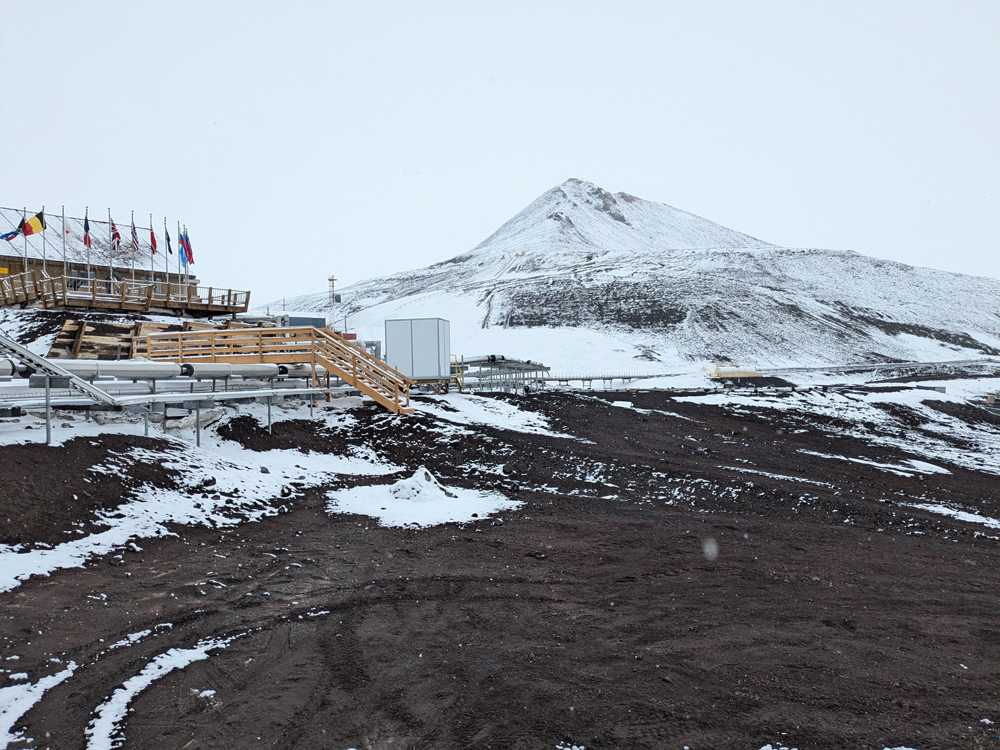
Snow at McMurdo Station, 27 December 2024
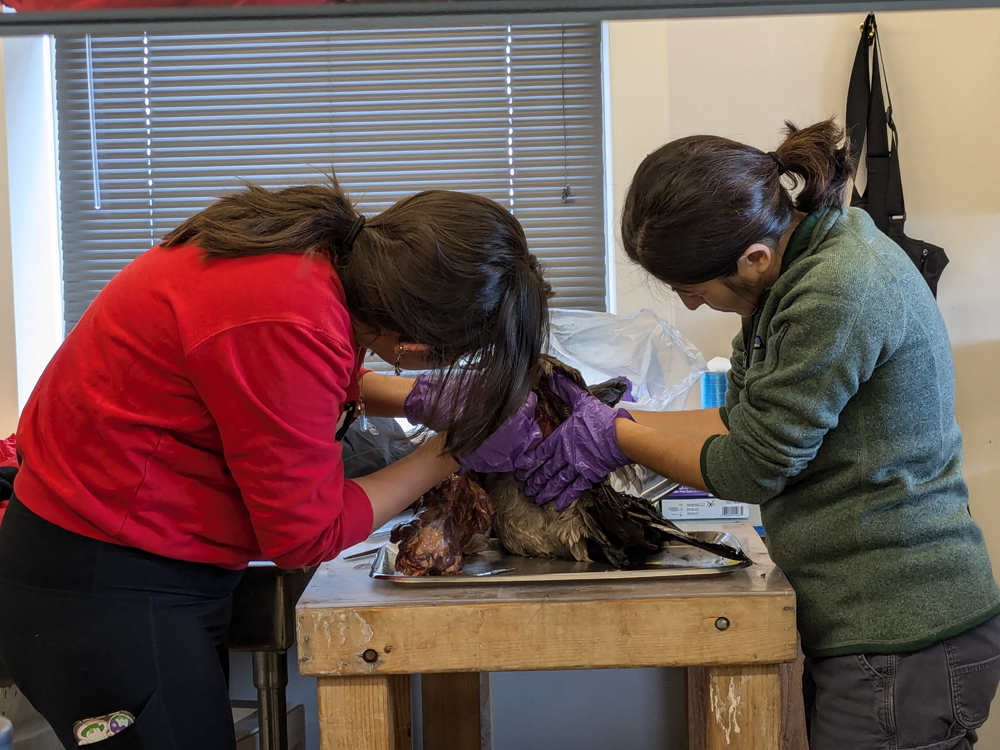
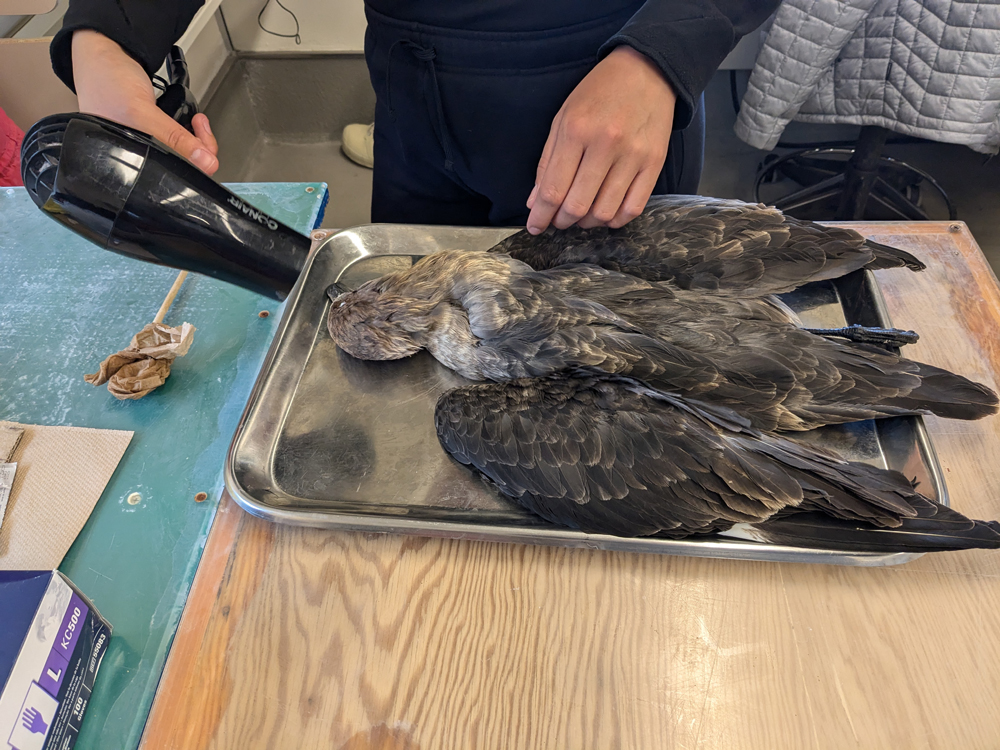
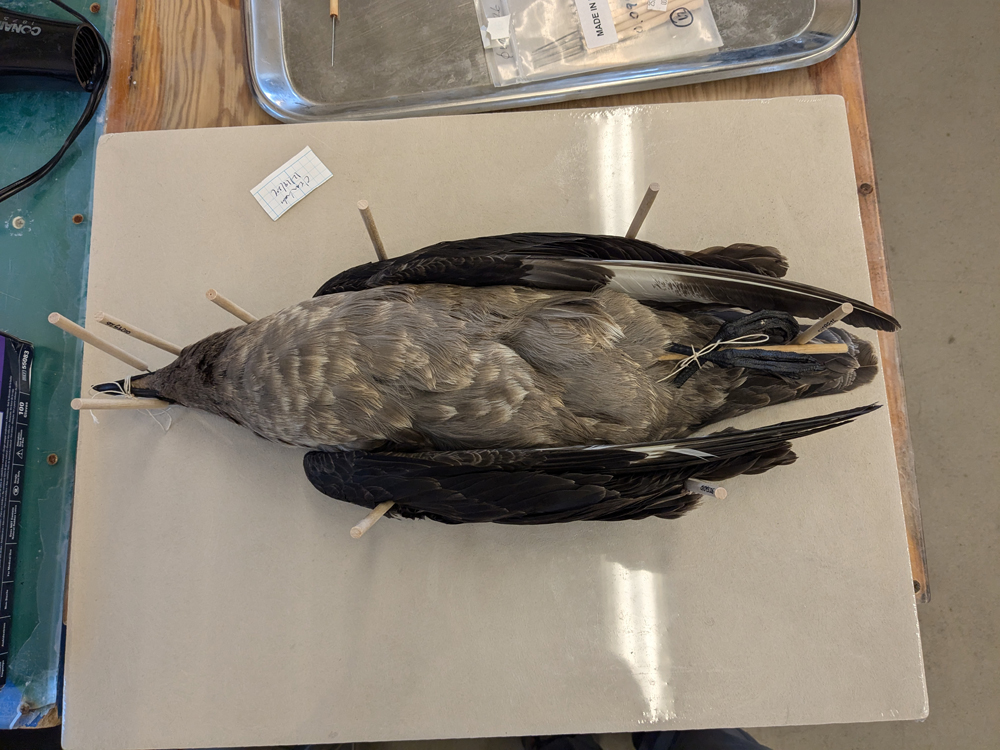
Valerie and Homa working on the South Polar Skua, then drying the skin after cleaning, and final prep and pinning out to dry in standard museum position.
Valerie's Blog Post:
The week before leaving I found I had trouble sleeping from a mix of nerves and excitement, the usual travel combo. Everything was finally setting in that I really was going to Antarctica after all the waiting and rigorous process to qualify. This would be my first long international flight, and first time truly leaving the continent of North America, so some extra nerves were involved. I would miss my cat, family and friends but everyone encouraged me that this would be a life changing experience!
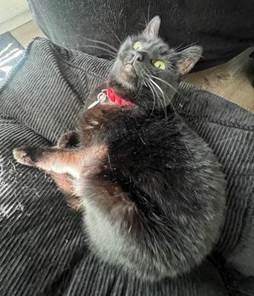
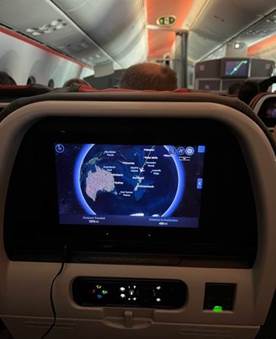 Surprisingly, there were only a few delays and no missed flights, so the airport timeseemed to go by relatively smooth. However, the long flight was quite brutal when it came to trying to rest, but when sleep escaped me, at least I had other forms of entertainment. Eventually, we got closer and closer to New Zealand whichwould be our temporary home until being sent to Antarctica. This was thrilling as New Zealand was a country I have always dreamt of visiting not only for its beautifullandscapes, unique wildlife, fascinating history, but its involvement in one of my favorite series, Lord of the Rings! We were only there for a few days and already had a full schedule both of trainings but also some site seeing. Luckily our hotel wasdowntown and proved to be easy access for all the restaurants, sites, and gardens the city of Christchurch had to offer. We got to exploring in our free time, saw a handful of native wildlife, and even got to meet a few local legends.
Surprisingly, there were only a few delays and no missed flights, so the airport timeseemed to go by relatively smooth. However, the long flight was quite brutal when it came to trying to rest, but when sleep escaped me, at least I had other forms of entertainment. Eventually, we got closer and closer to New Zealand whichwould be our temporary home until being sent to Antarctica. This was thrilling as New Zealand was a country I have always dreamt of visiting not only for its beautifullandscapes, unique wildlife, fascinating history, but its involvement in one of my favorite series, Lord of the Rings! We were only there for a few days and already had a full schedule both of trainings but also some site seeing. Luckily our hotel wasdowntown and proved to be easy access for all the restaurants, sites, and gardens the city of Christchurch had to offer. We got to exploring in our free time, saw a handful of native wildlife, and even got to meet a few local legends.
However, we also got down to business prepping for our flight to Antarctica. We had a few mandated trainings, try-ons for our ECW gear, and prep for what to expect for the flight south. Our flight was delayed but luckily it was only one extra day, other groups had been delayed for up to a week, so this was almost a relief. We ended up on a New Zealand military plane and they packed us in like sardines. The flight was quite uncomfortable/loud, but at least they gave us a decent brown bag lunch. Eventually we arrived on the seemingly mythical continent and allthe excitement reentered everyone’s faces. Here we all were, finally on the bottom of the world!
